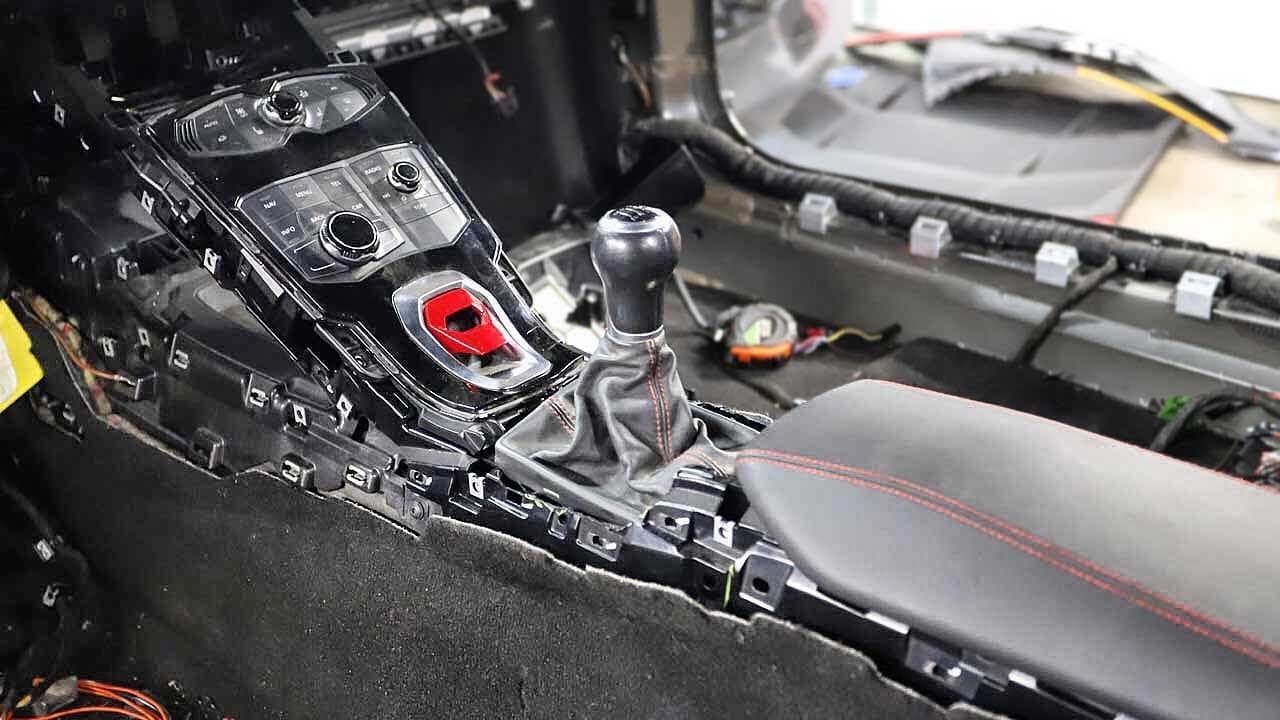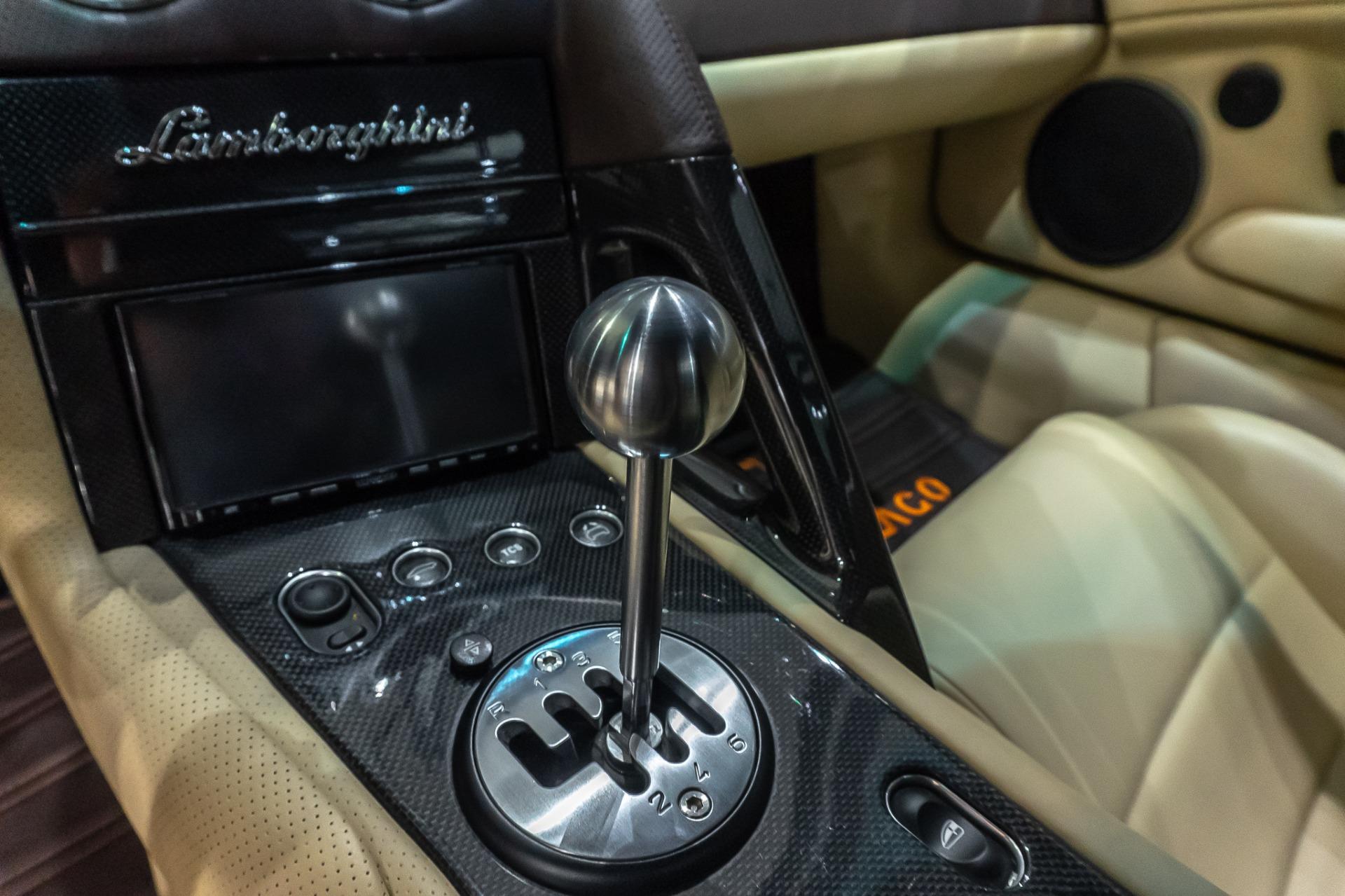Lamborghinis, known for their extraordinary performance and striking designs, have long been the epitome of automotive excellence. Among the many aspects that make these vehicles so special is their use of gated manual transmissions.
In this article, we will delve into the world of gated manual shifters, exploring their definition, advantages, historical significance, and, most notably, their presence in Lamborghini vehicles.
Understanding Gated Shifter
Gated manual transmissions, also known as gated shifters or gated gearboxes, are a specialized type of manual transmission commonly found in high-performance sports cars. The essential principle behind this design involves a metal plate or “gate” with distinct slots, guiding the gear lever’s movement into predetermined positions for gear selection. Unlike traditional H-pattern manual transmissions, gated shifters provide a unique and engaging feel during gear changes.
In comparison to the traditional H-pattern manual transmissions, gated shifters offer a more tactile and deliberate gear-shifting experience. The precise, notchy feel of the gate ensures accurate gear selection, reducing the risk of missing shifts and enhancing the overall driving experience.
Gated shifters typically consist of a beautifully crafted metal gate, which houses the gears’ slots in a visually appealing pattern. Underneath the gate, the gear lever moves with a satisfying click as it engages each gear. This design not only adds to the aesthetics of the interior but also provides an ergonomic advantage by reducing the chances of mis-shifting.
Advantages of Gated Manual Transmissions
One of the most prominent advantages of a gated manual transmission is the heightened driving experience it offers. The deliberate and mechanical nature of gear changes adds an unparalleled level of involvement for enthusiasts, making each shift a moment of connection between driver and machine.
Gated shifters excel in providing precise and accurate gear selection. The distinct slots in the gate make it nearly impossible to accidentally shift into the wrong gear, granting drivers the confidence to push their Lamborghinis to their limits on the track or open road.
Beyond the performance benefits, the presence of a gated shifter adds a touch of elegance and exclusivity to the interior of a Lamborghini. Car enthusiasts and collectors alike appreciate the artistry and craftsmanship that go into creating these beautiful manual gearboxes.
Gated Manual Transmissions in Automotive History
The history of gated manual transmissions traces back to the mid-20th century when sports car manufacturers sought to enhance the performance and driver engagement of their vehicles. Over time, advancements in engineering and materials have refined the design, elevating the gated shifter to the status of an automotive icon.
Several iconic Lamborghini models have embraced gated manual transmissions. Models like the Lamborghini Countach, Diablo, and Gallardo have become synonymous with the driving pleasure these gearboxes deliver. Other manufacturers, such as Ferrari and Aston Martin, have also used gated shifters in some of their most memorable models.
The use of gated manual transmissions in motorsports has had a profound impact on the racing heritage of Lamborghini and other manufacturers. These gearboxes were favored by drivers for their precision and ability to handle high-performance engines, making them instrumental in achieving victory on the track.
Difference between a Gated manual and a normal manual?

The difference between a gated manual and a normal manual lies in the shifter’s design and the driving experience it offers. Gated manual transmissions, also known as gated shifters, provide a unique and engaging feel during gear changes. The essential principle behind this design involves a metal plate or “gate” with distinct slots, guiding the gear lever’s movement into predetermined positions for gear selection. This gated design ensures a more tactile and deliberate gear-shifting experience.
On the other hand, a normal manual transmission, commonly referred to as an H-pattern manual transmission, follows a more conventional design. The gear lever moves in a pattern resembling the letter “H” to select gears, with each corner representing a different gear. While H-pattern transmissions are effective and widely used, they lack the distinct feedback and visual appeal of gated shifters.
The advantage of a gated manual lies in its precision and accuracy during gear selection. The distinct slots in the gate make it nearly impossible to accidentally shift into the wrong gear, granting drivers the confidence to push their vehicles to their limits on the track or open road. In contrast, traditional H-pattern manual transmissions require more attention and care from the driver to avoid misshifting.
Furthermore, gated shifters add a touch of elegance and exclusivity to the interior of a car. The presence of a beautifully crafted metal gate enhances the aesthetics and offers a glimpse into the artistry and craftsmanship that goes into creating these manual gearboxes. This aspect appeals to car enthusiasts and collectors who appreciate the added attention to detail in their automotive experience.
The key distinctions between a gated manual and a normal manual lie in their design, driving experience, and aesthetics. Gated manual transmissions offer a more engaging, precise, and visually captivating gear-changing experience, while traditional H-pattern manual transmissions provide a tried-and-true method of manually shifting gears. Both transmission types serve the same purpose, but gated shifters add an extra layer of driving pleasure and exclusivity to the overall experience behind the wheel.
Gated Shifter vs. Ratchet
In the realm of automatic transmission gear selector mechanisms, the decision often pivots around two major options: the iconic gated shifter and the efficient ratchet. Delving into their specifics offers a clearer perspective on their distinctive advantages and applications, and which might be more suited for a particular kind of driving experience.
A gated shifter is instantly recognizable due to its distinct “gates” or slots that guide the gear lever’s movement. This design demands the driver to navigate the lever through each specific gate to select the desired gear, ensuring both tactile feedback and the prevention of inadvertent gear shifts. The precision of gear selection offered by this setup reduces chances of mistakenly choosing the wrong gear, a feature that’s especially appealing to those who cherish the meticulousness of their driving experience.
Additionally, the aesthetics of gated shifters often resonate with luxury and sportiness, making them a favorite in high-end performance cars. However, this sophistication has its downsides. The need to move through each gate can render the gear shifting process slightly slower, and the intricate design could mean potential intricacies in manufacturing and repair.
On the other hand, the ratchet shifter, with its seemingly simplistic design, offers a different kind of efficiency. Absent of distinct gates, it allows for quick and almost intuitive gear changes with a mere push or pull. This feature is particularly advantageous in racing scenarios or vehicles with “manumatic” transmission functions that permit drivers to emulate the sensation of manual gear changes without using a clutch. The more direct mechanism potentially minimizes points of mechanical failure, but it’s not without its drawbacks. The simplicity that allows rapid shifts also increases the risk of inadvertent gear selection, especially for those unfamiliar with its operation. Additionally, some drivers might find the experience less tactile and engaging compared to the gated counterpart.
Can You Put a Gated Shifter On Any Car?
In theory, a gated shifter can be installed in any car with a manual transmission or an automatic transmission that permits manual gear selection. However, there are practical considerations and challenges involved:
- Transmission Compatibility: Not all transmissions are designed to be compatible with a gated shifter. Especially in the case of modern vehicles with electronic transmission controls, changing the shifter could interfere with the transmission’s operation or the electronic signals sent to and from the transmission.
- Physical Fitment: The space in the center console or the transmission tunnel must accommodate the gated shifter mechanism. In some vehicles, there might not be enough space, or the arrangement of components could make installation challenging.
- Functional Aspects: The new shifter has to align perfectly with the gear selector mechanism of the transmission. Improper alignment could lead to missed shifts or potential damage to the transmission.
- Safety Considerations: A crucial aspect of shifters is ensuring they can securely lock in park (for automatic transmissions) or neutral. Incorrect installations could lead to unsafe situations where the vehicle might roll unexpectedly.
- Aesthetic & Ergonomic Concerns: While a gated shifter can look visually appealing, it’s essential to ensure that its placement is ergonomic for the driver. A poorly positioned or angled shifter can make driving uncomfortable or more challenging.
- Cost & Expertise: Modifying a vehicle to accommodate a gated shifter, especially if it wasn’t designed for one, can be costly. It also requires expertise to ensure the shifter operates correctly and safely. This might involve custom fabrication or sourcing specific parts.
- Resale & Warranty: Altering a vehicle’s stock components can void warranties and might affect the vehicle’s resale value. Potential buyers might be wary of modifications, especially if they aren’t professionally done.
Notable Lamborghini with Gated Manual Transmissions
Notable Lamborghini models equipped with gated manual transmissions have left an indelible mark on the automotive world, captivating enthusiasts and collectors alike. Among these iconic vehicles, the Lamborghini Diablo, Gallardo, and Huracán stand out as prime examples of the brand’s commitment to providing an exceptional driving experience.

The Lamborghini Diablo, introduced in the early 1990s, remains a timeless classic. Powered by a monstrous V12 engine, the Diablo embodied the raw power and aggressive styling for which Lamborghini is renowned. Paired with a gated manual transmission, the driving experience was nothing short of exhilarating. Each shift through the gears was accompanied by the satisfying click of the gated shifter, making every drive an engaging and memorable event.
Following in the footsteps of Diablo’s success, Lamborghini presented the Gallardo in the early 2000s. This model showcased a more accessible entry point to the Lamborghini brand while retaining the allure of the gated manual transmission. With the option of all-wheel drive, the Gallardo appealed to a broader range of drivers without sacrificing the joy of shifting through the gears. Its design and performance prowess made it a standout in the supercar world.
As Lamborghini continued to push the boundaries of automotive engineering, the Huracán arrived on the scene, taking the legacy forward into the 2010s. Equipped with cutting-edge technology and a range of sophisticated driving aids, the Huracán delivered a seamless blend of performance and luxury. For purists, the availability of the gated manual transmission ensured that driving enthusiasts could savor the tactile experience of gear changes while benefiting from modern advancements.
These notable Lamborghini with gated manual transmissions represent the brand’s dedication to providing an authentic and engaging driving experience. Each model embodies Lamborghini’s commitment to pushing the boundaries of automotive performance while preserving the spirit of the iconic gated shifter. As Lamborghini continues to innovate and introduce new models, the allure of these manual gearboxes remains a defining aspect of the brand’s storied legacy.
Other Cars With The Best Gated Manual Shifters
- Ferrari 430 Scuderia: The Ferrari 430 Scuderia, which is a track-focused evolution of the F430, came with an iconic metal-gated shifter. The clink of the metal as it moves through the gears is a distinct pleasure. Ferrari has always had a flair for blending performance with elegance, and their gated shifter in the 430 Scuderia was a testament to that dedication.
- Audi R8 (First Generation): The first-generation Audi R8 offered a magnificent gated manual shifter. The precision, combined with the unmistakable sound, made changing gears in this mid-engine supercar a delight. The tactile feeling contributed greatly to the overall driving experience, making it a favorite among enthusiasts.
- Ferrari 360 Modena: An evolution in Ferrari’s lineage of mid-engine sports cars, the 360 Modena provided a very engaging drive. Its metal-gated shifter was instrumental in delivering a pure, connected feeling between the driver, the car, and the road.
- Maserati GranTurismo: While Maserati’s GranTurismo is often praised for its elegant design and soulful exhaust note, the gated shifter in the manual versions is a detail that shouldn’t be overlooked. It added an extra layer of tactile satisfaction to the driving experience.
- Ferrari Testarossa: A quintessential icon from the 80s and 90s, the Testarossa was as much a cultural statement as it was a performance machine. Its gated shifter only deepened the driver’s engagement with this flat-12-powered marvel.
Conclusion
Gated manual transmissions have become an integral part of Lamborghini’s heritage, offering enthusiasts an unparalleled driving experience and a tangible connection to the art of driving. With a history that spans iconic models and contributions to the world of motorsports, these beautifully crafted gearboxes are a testament to the passion and dedication of automotive engineering. As Lamborghini continues to evolve, the allure of gated manual transmissions will undoubtedly remain a cornerstone of the brand’s enduring appeal.



